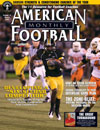Article CategoriesAFM Magazine
|
ADDING FLEXIBILITY TO YOUR DEFENSIVE GAME PLANby: Tod ThatcherDefensive Coordinator, San Benito High School (CA) © More from this issue As high school defensive coordinators, we are challenged on a weekly basis to stop a variety of offensive schemes. Over the course of last season, these offensive schemes included split-back veer, wing-t, fly, zone, pro-style, full-house double TE, and of course the spread offense. Our defensive staff has always prided itself in being able to prepare our players on a weekly basis to stop our opponent’s particular scheme, their most dominant player, and their bread-and-butter plays. Our base defense has always been a 3-4 with a cover 3 behind it. We feel that the 3-4 with a cover 3 gives us our best package to stop the variety of run and pass schemes we see in our section year-in and year-out. We try to be as multiple a 3-4 defense as we can by employing many shaded fronts, slants, line stunts, zone blitzes, and all c....The full article can only be seen by subscribers.
|
|
|||||||
| HOME |
MAGAZINE |
SUBSCRIBE | ONLINE COLUMNISTS | COACHING VIDEOS |
Copyright 2025, AmericanFootballMonthly.com
All Rights Reserved





